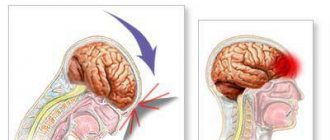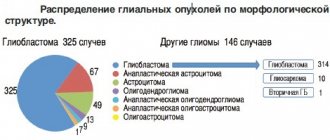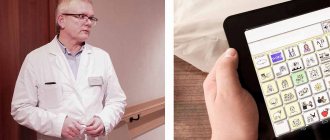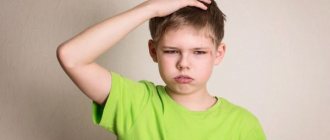Before moving on to the issue of rehabilitation after neurosurgery and traumatic brain injuries, you need to have a clear understanding of both.
Traumatic brain injury (TBI) is a set of contact injuries (soft tissues of the face and head, skull bones and facial skeleton) and intracranial injuries (damage to the substance of the brain and its membranes), having a single mechanism and age of formation. TBI is the third most common cause of death in the country (after cancer and cardiovascular diseases).
Neurosurgical surgery involves surgical treatment of diseases of the central and peripheral nervous system that arise both as a result of TBI or independently. The consequence of severe TBI and any neurosurgical intervention is a disruption of brain function of varying duration and severity, requiring further rehabilitation under the supervision of a neurologist. The rehabilitation program after TBI is highly individual and depends on the severity of the injury, the period of occurrence and the nature of the complications.
Differentiation of traumatic brain injuries
According to communication with the external environment, traumatic brain injuries, like fractures, can be open (penetrating, non-penetrating) and closed.
According to morphology, TBIs are divided into subtypes:
- Shake. The most gentle at first glance, but also the most insidious damage. The period of pronounced symptoms is up to several days.
- Squeezing. Pressure on the brain is exerted by a hematoma or the presence of air in the skull, or less often by a foreign body.
- Mild, moderate and severe brain contusion.
- Diffuse axonal damage - diffuse ruptures or tears of axons (coma with symptoms of brain stem damage).
- Subarachnoid hemorrhage is cerebral bleeding with a sharp headache and loss of consciousness in combination with hyperthermia and a meningeal symptom complex.
The combination of these injuries can be different, for example, bruise and compression or hemorrhage with bruise. Often there may be hemorrhage with the presence of a bruise and compression of the brain by the hematoma. Brain injury most often occurs at the site of impact, but often damage occurs on the opposite side of the skull - in the impact zone.
Modern approaches to complex neurorehabilitation of the consequences of traumatic brain injury
One of the leading neurological diseases at present is traumatic brain injury (TBI), since the number of patients with TBI increases annually by 2%, of which 1.5 million die and 2.5 million become disabled [1–3]. The prevalence of TBI in Europe is 150–300 (on average 235) per 100 thousand population, in the USA - 200–610 per 100 thousand, in Russia - 630 per 100 thousand, while the increase in incidence over the past 7 years was 17%, and mortality over the past 10 years has decreased by 46% [1, 2]. The absolute maximum incidence of TBI occurs in adolescence and young adulthood, and the circumstances leading to TBI are often associated with alcohol consumption and road traffic accidents [1–3]. The increase in the consequences of TBI, observed in the world over the past decade, is largely associated with the improvement of intensive care technologies, a decrease in the duration of hospitalization in the acute period of TBI and the duration of rehabilitation in the hospital, as well as the insufficient effectiveness of the most widely used traditional treatment and rehabilitation measures in the intermediate and long-term periods TBI, which leads to the persistence of pathological residual effects in 60–90% of patients [1, 3].
The classification of the consequences of TBI is under development and is not presented in ICD-10 and foreign guidelines on TBI. According to ICD-10, the consequences of TBI are classified in the T90 heading: “Consequences of head injuries.” In our country, an expanded and improved version of the classification of the consequences of TBI has been proposed [1]. Analysis of the prevalence of clinical manifestations of the consequences of TBI, in accordance with the working classification of clinical-functional syndromes [4], indicates that asthenic syndrome is observed in 64% of patients, vegetative-dystonic - in 58%, liquorodynamic - in 39%, cerebral-focal - in 36%, psychopathological - in 27%, post-traumatic epilepsy syndrome - in 12% [4].
The peculiarities of the clinical course and outcomes of TBI in childhood are due to the fact that mechanical energy affects the brain, the development and growth of which is not complete. There is a point of view according to which TBI in children is clinically milder than in adults due to low calcification and elasticity of the skull bones, open sutures between them, the presence of fontanelles, and incomplete differentiation of the structure of the nerve centers and circulatory systems of the brain [3, 5, 6] . Foreign researchers, when analyzing case histories of children and adults with severe TBI, noted that mortality in children after severe TBI was 24%, in adults 45%. After injury, a good outcome was observed in 55% of children and only 21% of adult victims [7, 8]. Domestic researchers also indicate that children are more likely than adults to have a favorable outcome, even after severe clinical variants of TBI, due to the high plasticity of the developing brain [1, 6]. At the same time, it is known that mild TBI suffered in childhood does not always go away without leaving a trace, and its consequences can appear years after the injury [3, 5].
Factors influencing the severity of the consequences of TBI in children are: 1) severity of injury; 2) age at which the injury occurred; 3) time elapsed since the injury; 4) localization of the traumatic lesion [2, 5, 6]. Most researchers indicate that with mild TBI, a more adequate response of cerebral systems is observed than with severe TBI [2, 6]. The consequences of mild TBI are determined by disturbances in the functional state of the activating system of the reticular formation of the anterior parts of the brain stem and the functionally associated nuclei of the subcortical ganglia [1, 2, 6]. More than half of the patients have postconcussion syndrome, which is characterized by decreased performance, memory, attention, the ability to quickly switch from one type of activity to another, headaches, dizziness, and sleep disturbances, which leads to decreased ability to work in adults and difficulties in schooling in children [ 6, 16]. According to our studies, cerebrasthenic disorders after TBI are observed in 64% of children, accompanied by a mild decrease in cognitive functions (up to 20%) and residual neurological disorders (muscle tone, coordination, cranial innervation) in 33–64% of cases [3] .
Moderate and severe TBIs lead to more serious consequences, which may not appear immediately, but may be delayed. If TBI affects the normal course of brain development, then as a result it affects the formation of the child’s personality, his cognitive and emotional development, school learning, and the formation of social skills. After moderate TBI, regression of pathological neurological symptoms is 60% of cases, stabilization - 30%, deterioration - 10%, and after severe injury, stabilization does not exceed 48% [1]. It has been shown that with severe TBI, 100% of children develop at least moderate disability, while with moderate TBI, moderate disability occurs in 65% of those examined [7]. The results of studies of quality of life characteristics indicate that adolescents in the long-term period of TBI, both severe and moderate, show insufficiency of general psychosocial functioning associated with problems of behavior, cognitive activity, general health and family relationships, as well as indicators of communication skills and daily self-care and general adaptive abilities [8].
It has been shown that after moderate and severe TBI, cerebrasthenic syndrome occurs in 94% of patients, school learning difficulties - in 93%, sleep disturbances - in 84%, decreased concentration - in 96%, memory impairment - in 78%, motor awkwardness - in 63%, speech disorders - in 40%, chronic post-traumatic headaches - in 95%. Movement coordination disorders were identified in 100% of patients, while coordination was reduced in adolescents with moderate TBI by 2.6 times, and in severe cases by 4 times, compared to healthy ones [6, 9]. According to the results of our studies, pathological neurological symptoms after moderate and severe TBI in children were observed in 92–100% of cases, complicated by manifestations of psychoorganic syndrome with a decrease in intellectual and mnestic functions in 90% of patients, speech disorders in 78–94%, which leads to to disruption of social adaptation, including the ability to learn in 36–62%, self-care in 62–83% of patients [3].
There is active debate about the fact that in children, not only the severity of TBI, but also the age at which it was suffered, influences the clinical manifestations of the disease, since it is known that functions developing after TBI may be affected to a greater extent than those , which had already formed before the injury [3, 6]. Many researchers note that TBI suffered in childhood negatively affects the further development of differentiation of functions of the central nervous system (CNS), while the consequences of TBI worsen with the age of the child [3, 6]. It has been shown that, compared to adult patients, adolescents do not have advantages in restoring neurological functions after severe TBI, although in some cases, in adolescents, as in children, after a TBI, including severe, a fairly rapid recovery of motor and sensory functions is possible. functions [3].
In recent years, the cognitive consequences of TBI have been classified as a separate group. According to ICD-10, cognitive impairment after TBI is classified within the framework of post-concussion syndrome (F07.2). Clinically, there are three levels of post-traumatic cognitive disorders: 1) traumatic cerebrastia (functional-dynamic disorders); 2) traumatic encephalopathy (impaired memory, intelligence, affective disorders); 3) traumatic dementia [1, 3].
The severity of cognitive impairment in the long-term period of TBI is largely determined by the initial degree of its severity [3]. A number of disorders of higher mental functions are caused by the specific localization of lesions, in particular the predominant lesion in brain contusions of the frontal and temporal lobes, as well as axial and subcortical formations [1, 3]. Cognitive disorders in patients who have suffered a TBI often affect such areas of mental activity as memory, attention, speed of processing incoming information, as well as executive functions (EF) provided by the prefrontal parts of the cerebral hemispheres - planning, organization, decision-making. Slower speed of intellectual processes and difficulties in organizing and managing complex information are two consistent manifestations of the consequences of TBI [9]. They make it very difficult for the patient to cope with tasks in a dynamic and complex environment, so returning to school, work and social life after TBI is associated with high fatigue, overexcitement and emotional distress. Particularly important is the psychoorganic syndrome that often occurs after moderate and severe TBI, which manifests itself in intellectual-mnestic decline, impaired criticism, and the emotional sphere [1, 3]. Some researchers note a total cognitive deficit after severe TBI [1, 3], while noting the importance of preserving the frontal lobes for the restoration of intellectual functions [9].
Post-traumatic epilepsy is a serious neurological consequence of TBI and often aggravates the manifestations of cognitive impairment. It was shown that the development of symptomatic post-traumatic epilepsy was observed in 5.7% of patients aged 4 to 14 years and occurred during the first year after suffering a closed moderate or severe TBI [1, 6]. Among the examined adolescents with consequences of TBI, 37% showed latent epileptiform activity on electroencephalography (EEG) [6]. In recent years, evidence has accumulated indicating the pathogenic impact on the central nervous system of long-term persistent epileptiform activity, even in the absence of epileptic attacks [1, 6].
Emotional and behavioral disorders in patients in the long-term period of TBI are characterized by the predominance of severe exhaustion and irritability in the picture of post-traumatic cerebral gravis, sometimes reaching affective explosiveness; motor disinhibition and impulsiveness are often noted; against this background, hysterical, neurasthenic, hypochondriacal or depressive symptoms often arise, which lead to difficulties in social contacts and relationships [1]. In a child or adolescent, residual effects after traumatic brain lesions serve as a predisposing factor when faced with difficult life circumstances to the emergence of psychogenic or neurotic disorders, and are a favorable basis for the pathological formation of personality.
Complex restorative treatment of the consequences of traumatic brain injury includes medical rehabilitation (physical therapy, massage, mechanotherapy, drug treatment, physiotherapy), psychological, pedagogical and speech therapy correction, and social and environmental adaptation [1, 3]. Treatment of motor, cognitive, emotional and behavioral disorders in children with consequences of TBI should be actively carried out both in the first year after the injury, when the effectiveness of rehabilitation is highest, and in the future, taking into account the development and high plasticity of the child’s central nervous system, with medication taking the leading place therapy using nootropic drugs [1, 3, 10, 11].
For more than 20 years, the complex neuropeptide drug Cortexin (MNN - polypeptides of the cerebral cortex of livestock) has been successfully used in the treatment of the consequences of TBI in adults and children [5, 6, 10–13]. Cortexin belongs to the pharmacological group 9.6 “Nootropics” (9.6.1. Nootropics in combinations). According to the ATC system (anatomical-therapeutic-chemical) classification, the drug belongs to heading N06 BX (“Other psychostimulants and nootropic drugs”). Cortexin is an innovative drug, its substance and dosage forms are protected by patents of the Russian Federation and other countries [5]. Cortexin contains a complex of low-molecular-weight water-soluble polypeptide fractions, a number of vitamins and minerals, which explains its high neurochemical activity in regulating the processes of neurocellular dynamics and apoptosis, providing mechanisms of neuroprotection. Cortexin is available as a lyophilisate in bottles of 10 mg and 5 mg (Cortexin for children). Before injection, the contents of the bottle are dissolved in 1.0–2.0 ml of a 0.5% solution of novocaine, water for injection or isotonic sodium chloride solution. The drug is prescribed intramuscularly, for children weighing up to 20 kg - at a dose of 0.5 mg/kg, and for children weighing more than 20 kg - at a dose of 10 mg. The duration of the course is 10–20 days. Cortexin is included in clinical recommendations for the treatment of children with diseases of the nervous system [16]. The results of numerous studies indicate the high effectiveness of Cortexin in the complex rehabilitation of patients with consequences of TBI, which is due to its direct effect on the metabolism of nerve cells, normalization of cerebral and systemic circulation, and reduction in the manifestations of convulsive syndrome [5, 6, 10, 11, 14, 15].
When examining 66 children with consequences of closed TBI aged from 1 year to 15 years, with an assessment of attention function (Bourdon's correction test), EEG dynamics, and the content of the brain fraction of the CPK-BB isoenzyme (correlating with impaired metabolism of nerve cells), it was shown that that when using Cortexin there was an improvement in attention indicators by 39%, which was 1.5 times higher than the results of traditional treatment, as well as a decrease in CPK-BB in the blood in 62% of patients, positive dynamics on the EEG in 76% of patients, in 70.2% a good result was achieved in correcting autonomic disorders, which was 2 times higher than the results of the control group [10]. In another study, when examining 30 patients aged 10–18 years, pronounced positive dynamics of the neurological status, with an improvement in the EEG pattern when using Cortexin in treatment, was observed in 65% of patients, moderate dynamics - in 35% of patients [10].
The results obtained during the examination of 187 patients with consequences of TBI showed that with the use of Cortexin, positive dynamics of restoration of cognitive functions (memory, attention, hand-eye coordination) was achieved in 61% of patients, positive dynamics on the EEG - in 49%, improvement in cerebral blood flow in according to rheoencephalography - in 40% [12]. Positive experience of using Cortexin in the treatment of chronic post-traumatic headache in children has also been demonstrated [13].
Thus, due to its complex effect on the main links in the pathogenesis of the consequences of TBI, Cortexin demonstrates high effectiveness in both acute and long-term periods of TBI in children, adolescents and adults.
An important modern direction in the rehabilitation of the consequences of TBI is mechanotherapy, based on the use of various simulators and specialized devices. In the rehabilitation therapy of patients with the consequences of TBI, the method of dynamic proprioceptive correction is actively used using therapeutic-load suits (Adeli, Gravist, Regent, etc.), based on strengthening and normalizing the afferent proprioceptive flow, which helps improve the maintenance of vertical posture and motor functions, reduction of contractures and deformities of the joints of the lower extremities, restructuring of the interaction of sensory systems, with an increase in the role of the visual analyzer, improvement of cognitive (including speech) functions [3].
Lokomat (a system from the Swiss company Hocoma) is easily integrated into the clinical process and is successfully used for the rehabilitation of patients with gait disorders starting from the age of 3 and allows for locomotor therapy using robotic orthoses on a treadmill, making it possible to conduct intensive locomotor training in patients with consequences TBI, stroke, cerebral palsy and other neurological diseases accompanied by paralysis of the lower extremities. The use of the robotic mechanotherapy complex “MotionMaker” (Swortec SA, Switzerland) also seems promising in the rehabilitation of patients with the consequences of TBI, which is the first device for the rehabilitation treatment of patients with severe movement disorders, combining robotic motor activity with functional electrical stimulation and closed-cycle electrical stimulation technology, when paralyzed muscles are involved in the process of movement even in the absence of control of voluntary movements.
In the rehabilitation of patients with the consequences of TBI, various methods of physical therapy are widely used: electrophoresis (with Eufillin, Dibazol, etc.), electromyostimulation, paraffin-ozokerite and mud applications, alternating magnetic field, while one of the modern promising methods is transcranial magnetic stimulation.
Thus, a differentiated approach, taking into account age aspects, clinical characteristics, and severity of the disease, helps to increase the effectiveness of complex rehabilitation and social adaptation in patients with consequences of traumatic brain injury.
Literature
- Konovalov A. N., Likhterman L. B., Potapov A. A. et al. Clinical guidelines for traumatic brain injury. M., 1998.
- Valiullina S. A., Roshal L. M., Albitsky E. V. et al. Traumatic brain injury in children: epidemiological and social features / Ed. V. Yu. Albitsky. M., 2012.
- Nemkova S. A. Rehabilitation using space technologies for children with consequences of traumatic brain injury. M.: Medpraktika-M, 2003. 220 p.
- Odinak M.M., Emelyanov A.Yu. Classification and clinical manifestations of the consequences of traumatic brain injuries // Military Medical Journal. 1998; 1:46–51.
- Nemkova S. A., Zavadenko N. N., Suvorinova N. Yu. Application of cortexin in complex neurorehabilitation in children // Russian Bulletin of Perinatology and Pediatrics. 2015, 2: 37–44.
- Nemkova S. A., Zavadenko N. N., Nesterovsky Yu. E. Cognitive impairment in children with consequences of traumatic brain injury // Questions of practical pediatrics. 2015, 10; 3:48–57.
- Thornhill S., Teasdale GM, Murray GD, McEwen J., Roy CW, Penny KI Disability in young people and adults one year after head injury: prospective cohort study // BMJ. 2000; 320:1631–1635.
- Stancin T., Drotar D., Taylor HG, Yeates KO, Wade SL, Minich NM Health-related quality of life of children and adolescents after traumatic brain injury // Pediatrics. 2002; 109:2–10.
- Howell D., Osternig L., Van Donkelaar P., Mayer U., Chou L. Effects of Concussion on Attention and Executive Function in Adolescents // Med. Sci. Sports. Exer. 2013; 45(6):1023–1029.
- Platonova T. N. Therapeutic correction of long-term consequences of acquired encephalopathies in children. Author's abstract. diss. Ph.D. honey. Sci. St. Petersburg, 1998. 24 p.
- Verizhnikova E. V., Sholomov I. I. Drug optimization of correction of traumatic brain injury in children and adolescents. In the book: Rehabilitation technologies of the 21st century. Saratov, 2006. pp. 26–27.
- Emelyanov A. Yu., Emelin A. Yu., Bitsadze A. N. Cortexin in the treatment of the consequences of brain injuries // Bulletin of the Russian Military Medical Academy. 2004; 2; 12:74–76.
- Bazarnaya N. A. Chronic post-traumatic headache in children. Author's abstract. diss. ... Ph.D. 2004. 26 p.
- Golovkin V.I., Bitsadze A.N. Restoring attention in the consequences of traumatic brain injury using the peptide bioregulator cortexin // Bulletin of hypnology and psychotherapy. 1991; 1:49–50.
- Emelyanov A. Yu. Cortexin as the basis for cerebroprotective therapy of the consequences of brain injuries // Medical Bulletin. 2007; 2–7.
- Child neurology. Clinical recommendations. Ed. Guzevoy V.I.M., 2014.
S. A. Nemkova, Doctor of Medical Sciences, Professor
GBOU VPO RNIMU im. N. I. Pirogova Ministry of Health of the Russian Federation , Moscow
Contact Information
Symptoms for various degrees of TBI severity
The severity of TBI is determined by the Glasgow Coma Scale (assessing the patient’s eye opening, movement and speech): mild – 13–15 points, moderate – 9–12 points, severe – 3–9 points. In other words, three factors are taken into account: state of consciousness, vital functions, neurological symptoms. In this case, the patient’s condition is assessed as satisfactory, moderate, severe, extremely severe, terminal (between life and death). The more serious the injury and the deeper its penetration, the more difficult the patient’s recovery.
Symptoms of TBI with:
- Mild severity: headache (cephalalgia), dizziness, nausea and vomiting, sleep disturbance, irritability, fatigue.
- Moderate: speech impairment, partial loss of vision, paroxysms of the limbs, mental disorders, memory loss, heart rhythm disturbances, high-intensity cephalgia, increased frequency of respiratory movements while maintaining rhythm, loss of consciousness for up to several hours.
- Severe: convulsions, paralysis, hypo- or hypertonicity of muscles, lack of consciousness for up to several weeks, coma, critical impairment of vital functions, deep brainstem and cerebral disorders.
Lesions and injuries
Traumatic brain injury (TBI) is an organic damage to the brain and brain structures (membranes, blood vessels, nerves) resulting from mechanical damage to the brain.
As a result of mechanical impact, nerve fibers are ruptured or damaged, which leads to a disruption in the transmission of nerve impulses. Such damage can occur in various areas of the brain responsible for speech, hearing, perception, attention, and memory.
Therefore, different people may experience different problems as a result of TBI - with memory, attention, perception and recognition. The result of traumatic brain injury is often disturbances in thinking, emotional sphere (depression, irritability), hearing impairment, writing, arithmetic, reading and speech.
Most of these violations can be compensated. After treatment of a TBI received in a hospital, the patient needs rehabilitation (elimination of the consequences of a traumatic brain injury) aimed at restoring lost functions.
At the DoctorNeuro Center for Speech Neurology, the condition of each patient is assessed by an interdisciplinary team of specialists. Doctors evaluate the problem comprehensively, each from the point of view of their specialization. In diagnosing the consequences of TBI, various functional diagnostic methods are used. The entire process of your rehabilitation will take place under the supervision of an experienced neurologist. He will study the medical history, prescribe an examination and a consultation of doctors, select medications and concomitant therapy, and monitor the progress of rehabilitation.
“Rehabilitation training can begin at any time, but the first year after injury and recovery from an acute condition is the most important for achieving maximum results.”
Krivtsova Yulianna Pavlovna, Neurologist of the first category
Survey
Neurologist
Rehabilitation after a TBI begins with an appointment with a neurologist. The doctor conducts an examination, studies existing medical documentation (discharge, CT, MRI reports) and, if necessary, prescribes additional examination. This may include functional diagnostics, computer diagnostics, laboratory tests, and examination of the patient by other specialists. The neurologist determines the scope of the necessary examination individually in each individual case.
The purpose of the examinations is to assess the volume, extent and type of impairments resulting from traumatic exposure. Based on the results of such a comprehensive examination (diagnosis), the doctor will be able to prescribe therapy and develop a rehabilitation route.
EEG
An electroencephalogram allows you to assess the functional state of the bioelectric activity of the brain to identify or exclude functioning pathologies in its individual areas.
USDG
Doppler ultrasound (USDG) of the vessels of the head and neck is prescribed to assess the degree of arterial and venous blood flow, exclude indirect signs of venous and intracranial hypertension, and diagnose vasospasm.
Oculist
The neurologist may prescribe an additional consultation with an ophthalmologist in order to exclude pathology from the fundus of the eye. Congestion in the fundus can serve as evidence of cerebral hypoxia, which is very important for the selection of drug therapy.
Neuropsychologist
Using special methods of neuropsychological diagnostics, a neuropsychologist identifies disturbances in the functioning of higher mental functions resulting from traumatic brain injury. The specialist assesses the state of the patient’s memory, attention, thinking, as well as the state of his emotional sphere (presence of aggression, irritability, depression) - it is with the problems identified during the examination that the neuropsychologist will work in the process of neurorehabilitation of the patient.
Speech therapist
The speech therapist evaluates the patient's speech if it is damaged.
Treatment
Based on a comprehensive examination and determination of the degree of damage to higher mental functions, a neurologist prescribes an individual neurorehabilitation program: both the necessary drug therapy and rehabilitation sessions with a neuropsychologist and speech therapist.
As an effective innovative treatment method, a neurologist can prescribe transcranial magnetic stimulation (TMS). This is a modern non-invasive technique for the treatment of neurological disorders. The effectiveness of TMS has been proven by both foreign and Russian experience.
The principle of operation of TMS is the painless and safe effect of short-term magnetic pulses on the affected nerve cells of the cerebral cortex, which significantly accelerates the restoration of the function of areas of the brain lost as a result of traumatic exposure.
TMS can be prescribed as monotherapy or work in combination with drug therapy.
Symptoms of TBI due to a recent head impact
- Headache,
- dizziness,
- Losing consciousness even for a few seconds,
- Falling asleep during the first two hours
- Nausea, vomiting,
- Visual impairment: pain in the eyes, displacement (bifurcation) of the image,
- Noise in ears,
- Retrograde amnesia (after a blow, events lasting from a few seconds to 2 hours may disappear from the victim’s memory).
Symptoms of TBI resulting from a head blow in the past (sometimes after 3-5 years)
- Frequent headaches
- Disturbance of sleep and/or sleep/wake cycle,
- Visual impairment,
- Impaired cognitive functions (impaired memory, concentration, fatigue, difficulty following the sequence of actions, etc.).
Periods, consequences and complications of TBI
The so-called traumatic disease includes three periods:
- Acute (duration 2 weeks – 2.5 months) – development of defense reactions to a damaging factor.
- Intermediate (duration 6 months – 1 year) – the process of lysis and repair in damaged areas.
- Long-term or final (duration 2-3 years, with complications - until the end of life) - completion of tissue degeneration and restoration of functions.
Complications of TBI in the acute phase:
- Impaired function of the respiratory system (respiratory depression and gas exchange disorders).
- Problems with central and regional (cerebral) circulation.
- Hemorrhagic complications (cerebral infarction, intracranial hemorrhage).
- Dislocation (displacement) of brain parts.
- Complications of a purulent-inflammatory nature: intracranial (abscesses, osteomyelitis, meningitis, encephalitis), extracranial (pneumonia, for example).
Possible consequences of TBI:
- Paralysis of the limbs (partial, complete) on one or both sides.
- Loss of vision, hearing, ability to speak, swallow, and breathe.
- Loss (weakening) of control over the function of the pelvic organs (the patient is not able to control the processes of urination and defecation).
- Tremor (shaking) in the limbs.
- Partial memory loss, deterioration of attention, changes in character and other consequences associated with higher nervous activity (usually after a coma).
In the long-term post-traumatic period, the development of epilepsy (acquired epilepsy), occlusive hydrocephalus, neuroses, and parkinsonism is possible. Also, cases of arachnoiditis and arachnoencephalitis (a disease of the central nervous system - serous (non-purulent) inflammation of the arachnoid membrane of the brain or spinal cord) are not uncommon.








